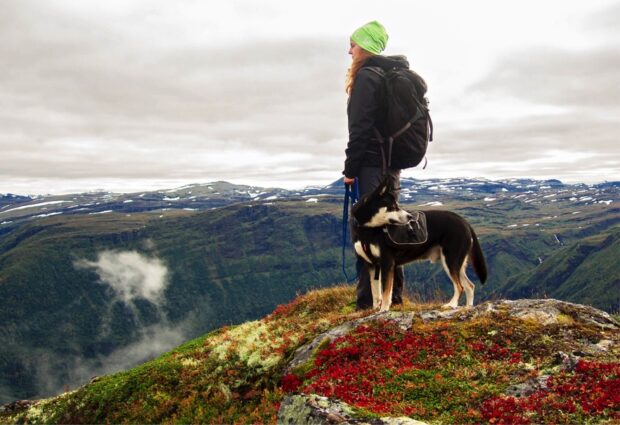Are you looking to take your dog hiking with you?
Loaded with energy and smiles, a dog can be the perfect hiking companion. However, just as you need to make sure you bring the right gear for yourself when hiking, so too do you need to make sure you do the same for your dog.

To ensure your pup stays healthy and safe on your hike, check out this guide to discover the top tips for hiking with your dog.
1. Pack the Right Gear
First things first, you need to remember to pack the right gear when hiking with your dog. Here are the top items you need to bring:
Pet First Aid Kit
Your pet first aid kit should include the following items:
- Tweezers
- Scissors
- Alcohol prep pads
- Gauze rolls
- Gauze pads
- Eyedropper
- Instant thermometer
- Soft muzzle
- Blanket/towel
- Hydrogen peroxide
- Vet’s contact information
- Flea and tick repellant
- Snakebite kit (if appropriate where you’re hiking)
Dog Rain Jacket
As you ascend a trail to a higher elevation, you’re much more likely to encounter rain.
Therefore, we suggest packing a rain jacket for your pup, and possibly even a winter jacket if it’s going to be a bit cold.
Pet Food and Bowls
Your dog needs to stay hydrated and fueled while hiking. Therefore, it’s very important to pack some pet food, water, and a pet bowl to dispense these items in.
Leash and Collar
Most hiking trails require that you keep your dog on a leash, so make sure to pack one even if you usually keep your dog off-leash. Also, make sure you put a collar on your dog with up to date ID information in case you get separated. You can visit Pet Life to find collars and leashes.
Dog Backpack
If you want your dog to use a doggie backpack, make sure he gets accustomed to it ahead of time.
In general, it’s recommended that the pack should never carry any more than 25% of your dog’s total weight. When your dog is getting used to the pack, make sure you place a few items in it, so it’s as close as possible to the weight it’ll be when you go hiking.
Also, keep in mind that your dog’s general health and age will also factor into how much they’re able to carry.
Dog Blanket
If you’re planning on going on an overnight hike, then a dog blanket is definitely necessary.
This will give your dog a spot to rest and keep warm. Plus, you can wrap the blanket around your dog for protection in an emergency situation.
Dog Booties
If you’re going to be hiking in rough terrain, dog booties are absolutely necessary to protect your pup’s precious paws.
You’ll want to take your dog on a few walks with their dog booties on before you head out for your big hike, as this will give your dog a chance to get accustomed to the way they feel.
2. Understand Your Dog’s Fitness Level
While your dog may have lots of energy, you need to make sure they have the fitness level required to take on a hike.
This will vary depending on your pet’s breed, age, weight, and health history. Certain breeds are more suitable to go on a adventurous hike, while some are more suited for leisure walks in the park. But before any exercise activities, do feed them well so that they will have enough energy. If your dog is a large breed dog such as great danes, it is recommended to provide them with the best dog food for great danes specifically. Also, keep the seasonal temperature in mind, as dogs can easily overheat if they’re exerting a lot of energy outdoors.
To understand what level of hike your dog can handle, we suggest talking with your vet. If your dog is new to hiking, we suggest starting with a gentle trail and then slowly building up from there.
Know what you need to take with you on a hike with your dog
3. Parasite Prevention
Lakes and rivers contain bacteria and parasites that can make your dog sick. One type of disease that is commonly found in stagnant water and soil is leptospirosis.
This flu-like disease does have a vaccine, however, it’s not effective against all strains. If you do decide to get this vaccine for your dog, opt for it two weeks before your hike, as this is how long it takes to take effect.
Otherwise, don’t allow your dog to drink from streams and rivers. Instead, bring along your own water for them.
4. Keep Trail Regulations in Mind
Last but not least, remember to keep trail regulations in mind. Following these regulations won’t only help keep your pup safe, but they’ll also help keep the trails safe and clean.
As we mentioned earlier, most trails require you to keep your dog on a leash. Also, remember that not all trails are dog-friendly, and some will even fine you if they catch you with your dog on a trail.
Just like humans, dogs should also only stay on marked trails, as this will protect them from ticks, poison ivy, and other hazards. Lastly, remember to clean up after your dog by burying their waste or packing it in a disposable bag.
The national park system has actually made it easy for owners to remember trail regulations with this simple anacronym: BARK. BARK stands for:
- Bag your dog’s waste
- Always keep your pet on a leash
- Respect wildlife
- Know where you’re going
5. Make Sure Your Dog is Properly Trained
As tempted as you may be to bring your new puppy out on the trail to burn off some steam, this may not be the best idea.
Keep in mind, you’re likely going to encounter other hikers on the trail, and they may not all be fans of dogs.
If your dog doesn’t yet know the commands for “heel”, “sit”, “stay”, and “come”, then they’re probably not quite ready to go on a hike. Some additional cues your dog should know include “leave it”, in case they pick up something they’re not supposed to, and “quiet”, in case they start barking loudly.
Follow these tips, and both you and your dog will have a great hike! Comment below if you have any questions.




